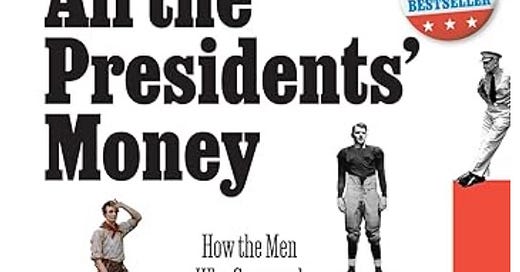BookLife Review by Carol O’Day: All the Presidents’ Money: How the Men Who Governed America Governed Their Money (Megan Gorman, author)
Non-fiction, history, personal finance, American Presidents, wealth-building, qualities and traits of successful and failed financial wealth-building, financial advisor, entrepreneurship, luck, grit.
In these hyper-political days and months of a Presidential election year, Megan Gorman’s book, All the Presidents’ Money: How the Men Who Governed America Governed Their Money, is like a refreshing weekend getaway where a reader can explore history and Presidents without toxicity or divisiveness. Gorman is a financial planning and tax expert for high-net worth individuals, with a robust resume of educational credentials and financial experience. Her depth and breadth of knowledge allow her to provide a level of analysis relying on primary resources surrounding the American Presidency through the lens of her experience as a seasoned financial planner and tax attorney. She understands wealth-building and the personal traits that promote or inhibit it on a level inaccessible to even the most scholarly Presidential historians. As a result, All the Presidents’ Money is imbued with a special sauce that sets the book apart from other works exploring the American Presidency.
The book is not structured as a chronicle of financial histories of selected Presidents. It takes a more sophisticated approach. Gorman first lays out the four fundamental building blocks of an individual’s personal biography that have the greatest impact on an individual’s financial fate : the ability to hold a vision of one’s future self (delayed gratification); education and pedigree; budgeting skill and affinity; and appetite for risk). As she probes these elements, she provides not only examples from Presidents’ histories but examples drawn from her experience with high net worth clients to illustrate the principles. From there, Gorman delves deeper. Using three sketches of Presidents who embody distinct views of money and wealth (financial confidence or anxiety, the value of money, and charitable intent), Gorman excavates the different philosophies which we hold that can determine our financial health and ability to build wealth. In the final segment of the book, Gorman focuses on three Presidential households (yes, spouses play a significant role) that failed and succeeded based on the principles she established in segments one and two. This portion of the book includes delightful inside-baseball type details which signal Gorman’s passion for the American Presidency and the deep primary source research behind her telling.
The book does not attempt to cover all 46 U.S. Presidents to date. Yet, it is expansive. Gorman selects and features Presidents who best exemplify the financial principles central to her thesis. She includes, to greater and lesser degrees, Presidents Washington, Jefferson, Lincoln, Grant, Monroe, Taft, Herbert Hoover, Coolidge, Roosevelt, Truman, Eisenhower, Kennedy, L. Johnson, Nixon, Ford, Carter, Reagan, Clinton, Biden and Trump. As a work of history and non-fiction, the prose is not particularly lyrical, but Gorman’s deeply researched historical anecdotes, which draw on rich primary sources and her detailed examples drawn from her client base provide the color. All the Presidents’ Money is a fresh take and read; it is unique and refreshing, as it stands at the infrequently visited intersection of history, personal and finance, and memoir. It is imminently accessible and a great book to add to your holiday list for history buffs and political junkies alike.
Support BookLife: Reviews for Readers and independent bookstores by purchasing All The Presidents Money: How The Men Who Governed America Governed Their Money using the link below:





